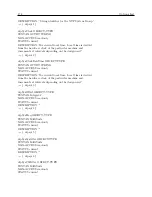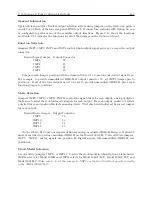
C.15 Option 34: NTP/PTP Server
177
::=
{
ntptrap 4
}
END
NTP MIB Object Definitions
•
ntpSysLeap
– two-bit code warning of an impending leap second to be inserted in the NTP
timescale.
•
ntpSysStratum
– indicating the stratum of the local clock.
0, unspecified; 1, primary
reference (e.g., calibrated atomic clock, radio clock); 2 – 255, secondary reference (via NTP).
•
ntpSysPrecision
– signed integer indicating the precision of the various clocks, in seconds
to the nearest power of two.
•
ntpSysRootDelay
– the total roundtrip delay to the primary reference source at the root
of the synchronization subnet, in seconds.
•
tpSysRootDispersion
– the maximum error relative to the primary reference source at the
root of the synchronization subnet, in seconds. Only positive values greater than zero are
possible.
•
ntpSysRefId
– the particular reference clock. In the case of stratum 0 (unspecified) or
stratum 1 (primary reference source), this is a pour-octet, left-justified, zero-padded ASCII
string. In the case of stratum 2 and greater (secondary reference) this is the four-octet Internet
address of the peer selected for synchronization.
•
ntpSysRefTime
– the local time when the local clock was last updated. If the local clock
as never been synchronized, the value is zero.
•
ntpSysPoll
– the minimum interval between transmitted messages, in seconds as a power of
two. For instance, a value of six indicates a minimum interval of 64 seconds.
•
ntpSysPeer
– the current synchronization source. Usually this will be a pointer to a structure
containing the peer variables. The special value NULL indicates there is no currently valid
synchronization source.
•
ntpSysPhase
– The system clock offset per selected source. (needs verification)
•
ntpSysFreq
– The system clock frequency correction per ntpd. (needs verification)
•
ntpSysError
– The current system error per ntpd? (needs verification)
•
ntpSysClock
– the current local time. Local time is derived from the hardware clock of the
particular machine and increments at intervals depending on the design used.
•
ntpSysSystem
– the type of local Operating System.
•
ntpSysProcessor
– the type of the local Processor.
Summary of Contents for 1092A
Page 4: ...iv ...
Page 18: ...xviii LIST OF TABLES ...
Page 129: ...C 10 Option 20A Four Fiber Optic Outputs 111 Figure C 7 Option 20A Jumper Locations ...
Page 131: ...C 11 Option 27 8 Channel High Drive 113 Figure C 8 Option 27 Jumper Locations ...
Page 148: ...130 Options List Figure C 10 Option 29 Connector Signal Locations ...















































